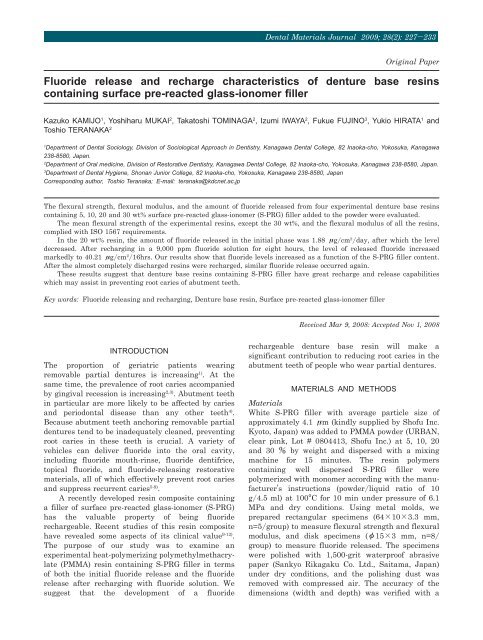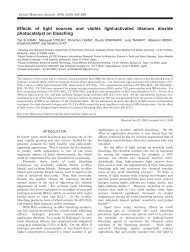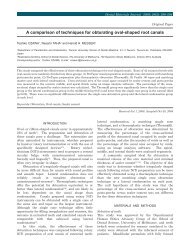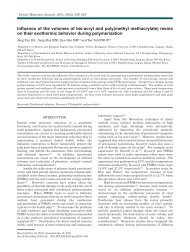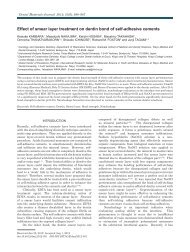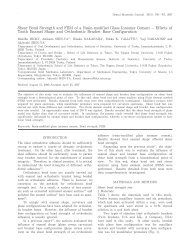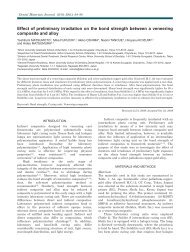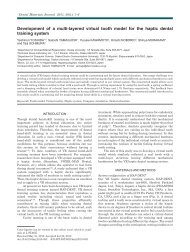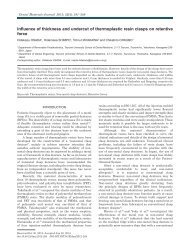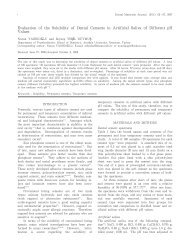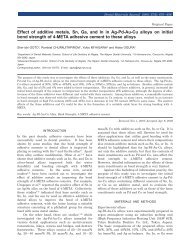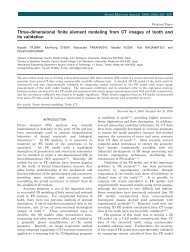Fluoride release and recharge characteristics of denture base resins ...
Fluoride release and recharge characteristics of denture base resins ...
Fluoride release and recharge characteristics of denture base resins ...
You also want an ePaper? Increase the reach of your titles
YUMPU automatically turns print PDFs into web optimized ePapers that Google loves.
Dental Materials Journal 2009; 28(2): 227-233<br />
Original Paper<br />
<strong>Fluoride</strong> <strong>release</strong> <strong>and</strong> <strong>recharge</strong> <strong>characteristics</strong> <strong>of</strong> <strong>denture</strong> <strong>base</strong> <strong>resins</strong><br />
containing surface pre-reacted glass-ionomer filler<br />
Kazuko KAMIJO 1 , Yoshiharu MUKAI 2 , Takatoshi TOMINAGA 2 , Izumi IWAYA 2 , Fukue FUJINO 3 , Yukio HIRATA 1 <strong>and</strong><br />
Toshio TERANAKA 2<br />
1<br />
Department <strong>of</strong> Dental Sociology, Division <strong>of</strong> Sociological Approach in Dentistry, Kanagawa Dental College, 82 Inaoka-cho, Yokosuka, Kanagawa<br />
238-8580, Japan.<br />
2<br />
Department <strong>of</strong> Oral medicine, Division <strong>of</strong> Restorative Dentistry, Kanagawa Dental College, 82 Inaoka-cho, Yokosuka, Kanagawa 238-8580, Japan.<br />
3<br />
Department <strong>of</strong> Dental Hygiene, Shonan Junior College, 82 Inaoka-cho, Yokosuka, Kanagawa 238-8580, Japan<br />
Corresponding author, Toshio Teranaka; E-mail: teranaka@kdcnet.ac.jp<br />
The flexural strength, flexural modulus, <strong>and</strong> the amount <strong>of</strong> fluoride <strong>release</strong>d from four experimental <strong>denture</strong> <strong>base</strong> <strong>resins</strong><br />
containing 5, 10, 20 <strong>and</strong> 30 wt% surface pre-reacted glass-ionomer (S-PRG) filler added to the powder were evaluated.<br />
The mean flexural strength <strong>of</strong> the experimental <strong>resins</strong>, except the 30 wt%, <strong>and</strong> the flexural modulus <strong>of</strong> all the <strong>resins</strong>,<br />
complied with ISO 1567 requirements.<br />
In the 20 wt% resin, the amount <strong>of</strong> fluoride <strong>release</strong>d in the initial phase was 1.88 μg/cm 2 /day, after which the level<br />
decreased. After recharging in a 9,000 ppm fluoride solution for eight hours, the level <strong>of</strong> <strong>release</strong>d fluoride increased<br />
markedly to 40.21 μg/cm 2 /16hrs. Our results show that fluoride levels increased as a function <strong>of</strong> the S-PRG filler content.<br />
After the almost completely discharged <strong>resins</strong> were <strong>recharge</strong>d, similar fluoride <strong>release</strong> occurred again.<br />
These results suggest that <strong>denture</strong> <strong>base</strong> <strong>resins</strong> containing S-PRG filler have great <strong>recharge</strong> <strong>and</strong> <strong>release</strong> capabilities<br />
which may assist in preventing root caries <strong>of</strong> abutment teeth.<br />
Key words: <strong>Fluoride</strong> releasing <strong>and</strong> recharging, Denture <strong>base</strong> resin, Surface pre-reacted glass-ionomer filler<br />
Received Mar 9, 2008: Accepted Nov 1, 2008<br />
INTRODUCTION<br />
The proportion <strong>of</strong> geriatric patients wearing<br />
removable partial <strong>denture</strong>s is increasing 1) . At the<br />
same time, the prevalence <strong>of</strong> root caries accompanied<br />
by gingival recession is increasing 2,3) . Abutment teeth<br />
in particular are more likely to be affected by caries<br />
<strong>and</strong> periodontal disease than any other teeth 4) .<br />
Because abutment teeth anchoring removable partial<br />
<strong>denture</strong>s tend to be inadequately cleaned, preventing<br />
root caries in these teeth is crucial. A variety <strong>of</strong><br />
vehicles can deliver fluoride into the oral cavity,<br />
including fluoride mouth-rinse, fluoride dentifrice,<br />
topical fluoride, <strong>and</strong> fluoride-releasing restorative<br />
materials, all <strong>of</strong> which effectively prevent root caries<br />
<strong>and</strong> suppress recurrent caries 5-9) .<br />
A recently developed resin composite containing<br />
a filler <strong>of</strong> surface pre-reacted glass-ionomer (S-PRG)<br />
has the valuable property <strong>of</strong> being fluoride<br />
<strong>recharge</strong>able. Recent studies <strong>of</strong> this resin composite<br />
have revealed some aspects <strong>of</strong> its clinical value 9-12) .<br />
The purpose <strong>of</strong> our study was to examine an<br />
experimental heat-polymerizing polymethylmethacrylate<br />
(PMMA) resin containing S-PRG filler in terms<br />
<strong>of</strong> both the initial fluoride <strong>release</strong> <strong>and</strong> the fluoride<br />
<strong>release</strong> after recharging with fluoride solution. We<br />
suggest that the development <strong>of</strong> a fluoride<br />
<strong>recharge</strong>able <strong>denture</strong> <strong>base</strong> resin will make a<br />
significant contribution to reducing root caries in the<br />
abutment teeth <strong>of</strong> people who wear partial <strong>denture</strong>s.<br />
MATERIALS AND METHODS<br />
Materials<br />
White S-PRG filler with average particle size <strong>of</strong><br />
approximately 4.1 μm (kindly supplied by Sh<strong>of</strong>u Inc.<br />
Kyoto, Japan) was added to PMMA powder (URBAN,<br />
clear pink, Lot # 0804413, Sh<strong>of</strong>u Inc.) at 5, 10, 20<br />
<strong>and</strong> 30 % by weight <strong>and</strong> dispersed with a mixing<br />
machine for 15 minutes. The resin polymers<br />
containing well dispersed S-PRG filler were<br />
polymerized with monomer according with the manufacturer’s<br />
instructions (powder/liquid ratio <strong>of</strong> 10<br />
g/4.5 ml) at 100°C for 10 min under pressure <strong>of</strong> 6.1<br />
MPa <strong>and</strong> dry conditions. Using metal molds, we<br />
prepared rectangular specimens (64×10×3.3 mm,<br />
n=5/group) to measure flexural strength <strong>and</strong> flexural<br />
modulus, <strong>and</strong> disk specimens (φ15×3 mm, n=8/<br />
group) to measure fluoride <strong>release</strong>d. The specimens<br />
were polished with 1,500-grit waterpro<strong>of</strong> abrasive<br />
paper (Sankyo Rikagaku Co. Ltd., Saitama, Japan)<br />
under dry conditions, <strong>and</strong> the polishing dust was<br />
removed with compressed air. The accuracy <strong>of</strong> the<br />
dimensions (width <strong>and</strong> depth) was verified with a
228<br />
Dent Mater J 2009; 28(2): 227-233<br />
micrometer (MDC-MJ/PJ, Mitutoyo, Tokyo, Japan)<br />
to within 1 μm at three locations in each dimension<br />
with a 0.02 mm tolerance. As a control group, we<br />
used the same resin without S-PRG filler (0 wt%).<br />
Methods<br />
Flexural strength <strong>and</strong> flexural modulus<br />
The specimens were tested for flexural strength <strong>and</strong><br />
flexural modulus according to ISO 1567 13) . Before<br />
testing, specimens were stored in deionized water<br />
(DW) for 50 hours at 37 °C. To determine flexural<br />
strength, five specimens were subjected to threepoint<br />
bending tests using a universal testing machine<br />
(AGS-1000, Shimadzu Corp., Kyoto, Japan) at a<br />
crosshead speed <strong>of</strong> 1 mm/min. The flexural modulus<br />
was calculated from the linear portion <strong>of</strong> the loadtime<br />
curve up to the proportional limit obtained by<br />
the bending test.<br />
According to ISO 1567 13) the minimum flexural<br />
strength <strong>of</strong> Type 1 <strong>denture</strong> <strong>base</strong> materials (heatpolymerized<br />
polymers) should not be less than 65<br />
MPa, <strong>and</strong> the minimum flexural modulus should not<br />
be less than 2 GPa.<br />
Measurement <strong>of</strong> <strong>release</strong>d fluoride<br />
Phase 1 (phase <strong>of</strong> initial fluoride <strong>release</strong>; day 1 to day<br />
15)<br />
Each specimen <strong>of</strong> <strong>denture</strong> <strong>base</strong> resin was placed in<br />
3.0 ml <strong>of</strong> DW for 15 days at 37 °C. The fluoride-ion<br />
concentration <strong>of</strong> the resulting solutions was measured<br />
daily, except on days 5, 6, 8 <strong>and</strong> 13, <strong>and</strong> the resulting<br />
solutions were discarded. A 0.3 ml total ionic<br />
strength adjustment buffer III (Catalogue number<br />
940911, Thermo Orion, Beverly, MA, USA) was<br />
added to the solution, then a combination fluoride<br />
electrode (Orion 9609BN, Thermo Orion) was<br />
inserted, connected to a 720A plus fluoride-ion meter<br />
(Thermo Orion). <strong>Fluoride</strong> concentration was<br />
measured while the solution was stirred at room<br />
temperature, <strong>and</strong> the amount <strong>of</strong> fluoride <strong>release</strong>d per<br />
unit surface area (cm 2 ) <strong>of</strong> the resin disk was<br />
computed. After each measurement the resulting<br />
solution was discarded <strong>and</strong> replaced with fresh DW.<br />
Phase 2 (phase <strong>of</strong> fluoride <strong>release</strong> after recharging;<br />
day16 to day 49)<br />
At the end <strong>of</strong> phase 1, each sample was stored in 3.0<br />
ml <strong>of</strong> sodium fluoride solution (9,000 ppm fluoride)<br />
for eight hours. The specimens were then rinsed with<br />
DW for five seconds prior to storing in 3.0 ml DW for<br />
16 hours, followed by another rinse <strong>and</strong> storing in<br />
fresh DW for a further 24 hours. This sequence was<br />
repeated five times during the next 10 days. The<br />
fluoride-ion concentration <strong>of</strong> each solution after the<br />
storage period <strong>of</strong> either 16 hours or 24 hours was<br />
measured in the same manner as in phase 1. This<br />
procedure simulates a common pattern among<br />
<strong>denture</strong> wearers in which they store their <strong>denture</strong>s<br />
in a fluoride solution during periods <strong>of</strong> sleep every<br />
other day.<br />
Phase 3 (phase <strong>of</strong> confirmation <strong>of</strong> fluoride recharging;<br />
day 50 to day 60)<br />
At the end <strong>of</strong> the phase 2, the specimens <strong>of</strong> <strong>denture</strong><br />
<strong>base</strong> resin were immersed in DW which was<br />
discarded <strong>and</strong> replaced every day for 24 days until<br />
the <strong>release</strong> <strong>of</strong> fluoride had diminished to trace levels.<br />
To confirm the fluoride recharging ability, we<br />
immersed the specimens in 3.0 ml <strong>of</strong> 9,000 ppm<br />
fluoride solution for eight hours to <strong>recharge</strong>. The<br />
specimens were rinsed with DW for five seconds <strong>and</strong><br />
then immersed in 3.0 ml DW for 16 hours. We then<br />
measured the fluoride-ion concentration <strong>and</strong> replaced<br />
it with fresh DW. This procedure was repeated over<br />
the next 10 days except on days 55 <strong>and</strong> 57, using the<br />
same procedure as in phase 1. The amount <strong>of</strong> fluoride<br />
<strong>release</strong>d into the immersing solution was determined<br />
using the same procedure as in phases 1 <strong>and</strong> 2.<br />
STATISTICAL ANALYSIS<br />
There were five specimens for the flexural strength<br />
<strong>and</strong> flexural modulus determination, <strong>and</strong> eight<br />
specimens for the measurement <strong>of</strong> fluoride concentration<br />
in each <strong>of</strong> five groups. We statistically analyzed<br />
fluoride <strong>release</strong> with two-way repeated-measures<br />
ANOVA, followed by Tukey’s HSD multiple<br />
comparison test at the <strong>release</strong> peak selected date in<br />
phases 1, 2 <strong>and</strong> 3 ( Dr. SPSS II, Nankodo Inc., Tokyo,<br />
Japan). Differences with p values
Dent Mater J 2009; 28(2): 227-233 229<br />
Fig. 1<br />
Flexural strength <strong>of</strong> experimental <strong>denture</strong> <strong>base</strong><br />
<strong>resins</strong><br />
Mean ± SD, n=5<br />
Resin powder contained 5, 10, 20 <strong>and</strong> 30 wt% S-<br />
PRG filler. Control was conventional <strong>denture</strong> <strong>base</strong><br />
resin without S-PRG filler. The minimum flexural<br />
strength should not be less than 65 MPa (ISO<br />
1567).<br />
Fig. 2<br />
Flexural modulus <strong>of</strong> experimental <strong>denture</strong> <strong>base</strong><br />
<strong>resins</strong><br />
Mean ± SD, n=5<br />
Resin powder contained 5, 10, 20 <strong>and</strong> 30 wt% S-<br />
PRG filler. Control was conventional <strong>denture</strong> <strong>base</strong><br />
resin without S-PRG filler. The minimum flexural<br />
modulus should not be less than 2GPa (ISO 1567).<br />
Fig. 3<br />
Amount <strong>of</strong> fluoride <strong>release</strong>d in each phase<br />
Unit indications without circle : μg/cm 2 /day, with circle : μg/cm 2 /16hrs.<br />
Phase 1: Initial fluoride <strong>release</strong> from the <strong>denture</strong> <strong>base</strong> <strong>resins</strong>. <strong>Fluoride</strong> concentration rapidly decreased with an<br />
increase in the immersion period. Phase 2: <strong>Fluoride</strong> <strong>release</strong> after fluoride recharging. All experimental <strong>resins</strong><br />
<strong>release</strong>d approximately 20 times the amount <strong>of</strong> fluoride <strong>of</strong> phase 1. Phase 3: The amount <strong>of</strong> fluoride <strong>release</strong>d from<br />
the specimens after fluoride was expended <strong>and</strong> the specimens were <strong>recharge</strong>d. The fluoride <strong>release</strong> returned as<br />
with phase 2.
230<br />
Dent Mater J 2009; 28(2): 227-233<br />
Table 1<br />
Amount <strong>of</strong> fluoride <strong>release</strong> in phase 1 (μg/cm 2 /day)<br />
day<br />
1<br />
2<br />
3<br />
4<br />
7<br />
9<br />
10<br />
11<br />
12<br />
14<br />
15<br />
(μg/cm 2 /day) (μg/cm 2 /day) (μg/cm 2 /day) (μg/cm 2 /day) (μg/cm 2 /day) (μg/cm 2 /day) (μg/cm 2 /day) (μg/cm 2 /day) (μg/cm 2 /day) (μg/cm 2 /day) (μg/cm 2 /day)<br />
control ND ND ND ND ND ND ND ND ND ND ND<br />
5wt% 0.70(0.07)a 0.29(0.03)a + 0.20(0.03)a + 0.21(0.03)a + 0.10(0.01)a+ tr tr tr tr tr tr<br />
10wt% 1.00(0.09)b 0.40(0.04)b + 0.32(0.03)b + 0.33(0.03)b + 0.15(0.02)b + 0.11(0.01)a + 0.14(0.01)a + 0.15(0.02)a + 0.18(0.02)a + 0.22(0.03)a + 0.11(0.03)a +<br />
20wt% 1.88(0.32)c 0.85(0.12)c + 0.73(0.06)c + 0.70(0.04)c + 0.36(0.04)c + 0.27(0.02)b + 0.34(0.03)b + 0.34(0.03)b + 0.34(0.02)b + 0.31(0.03)b + 0.15(0.03)b +<br />
30wt% 2.91(0.16)d 1.37(0.12)d + 1.10(0.06)d + 1.10(0.08)d + 0.64(0.06)d + 0.47(0.03)c + 0.60(0.08)c + 0.60(0.07)c + 0.62(0.07)c + 0.53(0.05)c + 0.26(0.03)c +<br />
n=8, mean (SD)<br />
ND: not detectable (less than 0.022 μg/cm 2 ), tr: trace (less than 0.10 μg/cm 2 ), +: significantly different from day 1 (p0.05) on the same experimental day.<br />
Significant differences were found between the groups on day 1 (p0.05).<br />
All groups maintained fluoride <strong>release</strong> following recharging during the whole experimental period.<br />
<strong>Fluoride</strong> <strong>release</strong><br />
Figure 3 shows the amount <strong>of</strong> fluoride <strong>release</strong>d in<br />
phases 1, 2 <strong>and</strong> 3. Tables 1, 2 <strong>and</strong> 3 summarize the<br />
results <strong>of</strong> the determined fluoride amounts in phases<br />
1, 2 <strong>and</strong> 3 respectively.<br />
Phase 1<br />
On day 1, fluoride ions were <strong>release</strong>d into the DW<br />
from the experimental <strong>denture</strong> <strong>base</strong> <strong>resins</strong> at levels<br />
<strong>of</strong> 0.70, 1.00, 1.88 <strong>and</strong> 2.91 μg/cm 2 /day for<br />
specimens with 5, 10, 20 <strong>and</strong> 30 wt% <strong>of</strong> S-PRG,<br />
respectively. Significant differences were found<br />
between the groups (p
Dent Mater J 2009; 28(2): 227-233 231<br />
Table 3 Amount <strong>of</strong> fluoride <strong>release</strong> in phase 3<br />
day<br />
50<br />
(μg/cm 2 /16hrs)<br />
51<br />
(μg/cm 2 /day)<br />
52<br />
(μg/cm 2 /day)<br />
53<br />
(μg/cm 2 /day)<br />
54<br />
(μg/cm 2 /day)<br />
56<br />
(μg/cm 2 /day)<br />
58<br />
(μg/cm 2 /day)<br />
59<br />
(μg/cm 2 /day)<br />
60<br />
(μg/cm 2 /day)<br />
control 0.96(0.58)a 0.03(0.02)a tr ND ND ND ND ND ND<br />
5wt% 3.02(0.56)ab 0.17(0.02)ab tr tr tr tr ND ND ND<br />
10wt% 10.02(1.90)bc 1.07(0.29)b 0.50(0.30)a 0.25(0.14)a 0.19(0.07)a 0.15(0.05)a tr tr 0.13(0.13)a<br />
20wt% 45.34(3.56)d 5.62(0.99)b 2.64(1.20)b 1.79(0.60)b 1.12(0.22)b 0.84(0.19)b 0.63(0.15)a 0.44(0.11)a 0.56(0.42)a<br />
30wt% 98.14(11.19)e 15.51(3.93)c 6.83(1.30)c 4.66(0.88)c 3.41(0.50)c 3.00(1.44)c 1.87(0.35)b 2.51(2.87)b 1.45(0.32)b<br />
n=8, mean (SD)<br />
ND: not detectable (less than 0.022 μg/cm 2 ), tr: trace (less than 0.10 μg/cm 2 )<br />
Values with the same letters are not significantly different (p>0.05) on the same experimental day.<br />
The fluoride <strong>release</strong> returned as with phase 2 on day 50.<br />
ing value on day 1 in phase 1 (Figure 3 <strong>and</strong> Table 2).<br />
These values increased markedly in proportion to the<br />
loading <strong>of</strong> S-PRG filler. On day 17, the amount <strong>of</strong><br />
fluoride <strong>release</strong>d decreased significantly (p
232<br />
Dent Mater J 2009; 28(2): 227-233<br />
were the easiest to <strong>recharge</strong>. According to Shaw et<br />
al. 22) , the initial amount <strong>of</strong> fluoride <strong>release</strong> by a<br />
conventional glass ionomer was 105 μg/cm 2 on day 1<br />
<strong>and</strong> 33 μg/cm 2 on day 10, after which it gradually<br />
decreased. In compomers, fluoride <strong>release</strong> decreased<br />
from 8 μg/cm 2 on day 1 to 5 μg/cm 2 on day 10 in<br />
the same study. In the present study, even the<br />
highest values obtained from the 30 wt% group were<br />
2.91 μg/cm 2 /day on day 1 <strong>and</strong> 0.60 μg/cm 2 /day on<br />
day 10. These values were almost 1/3 <strong>and</strong> 1/6 <strong>of</strong> the<br />
values <strong>of</strong> conventional glass ionomers at the same<br />
time intervals. In the present study, even the highest<br />
values obtained from the 30 wt% group were 2.91<br />
μg/cm 2 /day on day 1 <strong>and</strong> 0.60 μg/cm 2 /day on day<br />
11. These values were extremely low in comparison<br />
with Shaw’s study <strong>and</strong> were approximately 1/35 <strong>and</strong><br />
1/55 <strong>of</strong> the values obtained with conventional glass<br />
ionomers on day 1 <strong>and</strong> day 10 respectively.<br />
Nevertheless, the amount <strong>of</strong> fluoride <strong>release</strong>d after<br />
recharging with a solution <strong>of</strong> sodium fluoride was<br />
12.50, 22.00, 40.21 <strong>and</strong> 67.81 μg/cm 2 /16hrs from the<br />
5, 10, 20 <strong>and</strong> 30 wt% specimens respectively on day<br />
16. These values were approximately 12–70% <strong>of</strong> the<br />
amount <strong>of</strong> fluoride <strong>release</strong>d by glass ionomers on day<br />
1. According to ten Cate et al. 26,27) , demineralization<br />
inhibition depends on fluoride concentration, <strong>and</strong><br />
microradiographic data in vitro showed that 2 ppm<br />
fluoride in artificial saliva containing calcium <strong>and</strong><br />
phosphate at pH 4.5 inhibited demineralization <strong>of</strong><br />
enamel lesions, while dentin demineralization was<br />
inhibited in clinically relevant percentages (40%) at<br />
fluoride levels above 1 ppm. However, these fluoride<br />
concentrations would be toxic in clinical situations 28) .<br />
In our study, the total amounts <strong>of</strong> fluoride <strong>release</strong>d<br />
were 5.61, 9.86, 18.1 <strong>and</strong> 30.4 ppm/3 ml/ day <strong>of</strong> the<br />
5, 10, 20 <strong>and</strong> 30 wt% specimens respectively on day<br />
16. These levels are sufficient to prevent dentin<br />
lesion formation in the narrow space between<br />
<strong>denture</strong>s <strong>and</strong> abutment teeth without causing<br />
toxicity.<br />
Some reports show that fluoride may induce<br />
corrosion <strong>of</strong> alloys. Nakagawa et al. 29) reported that<br />
pure titanium <strong>and</strong> titanium alloys were corroded by<br />
fluoride at half or less than half <strong>of</strong> the concentration<br />
currently found in commercial dentifrices less than<br />
453 ppm fluoride. Watanabe et al. 30) reported that<br />
several applications <strong>of</strong> acidulated fluoride agents<br />
may cause discoloration <strong>of</strong> β-titanium alloy wires.<br />
However, these problems occurred with excessive<br />
fluoride concentrations <strong>and</strong> at low pH; these<br />
conditions are unlikely to arise during clinical use 31) .<br />
The experimental <strong>denture</strong> <strong>base</strong> resin containing<br />
S-PRG filler used in the present study <strong>release</strong>s<br />
fluoride ions on contact with water. The amount <strong>of</strong><br />
fluoride <strong>release</strong>d increases as a function <strong>of</strong> filler<br />
content. In addition, when this <strong>denture</strong> <strong>base</strong> resin is<br />
<strong>recharge</strong>d with fluoride solution, it retains excellent<br />
fluoride releasing ability. However, because an<br />
increase in filler content correlates with a decrease<br />
in the durability <strong>and</strong> strength <strong>of</strong> the <strong>denture</strong> <strong>base</strong><br />
resin, it is important to determine the optimal<br />
percentage <strong>of</strong> filler that satisfies the need for fluoride<br />
<strong>release</strong> while maintaining acceptable strength. Silane<br />
coupling agents, which we did not use in this study,<br />
would help to give strength to resin mixtures that<br />
have a greater fraction <strong>of</strong> filler.<br />
Our results show that this experimental <strong>denture</strong><br />
<strong>base</strong> resin can be <strong>recharge</strong>d with fluoride by soaking<br />
<strong>denture</strong>s during non-wearing hours in a fluoridecontaining<br />
<strong>denture</strong> cleaner or solution for preserving<br />
<strong>denture</strong>s. Wearing a fluoride-<strong>recharge</strong>d <strong>denture</strong> in<br />
the oral cavity will provide enough fluoride to inhibit<br />
demineralization <strong>and</strong> enhance remineralization<br />
around abutment teeth, thereby preventing caries. In<br />
addition to preventing caries among patients who<br />
require care <strong>and</strong> who have poor oral hygiene, such as<br />
the geriatric <strong>and</strong> person with special needs, this<br />
fluoride-releasing resin can be incorporated into<br />
bleaching trays for at-home bleaching, orthodontic<br />
retainers, <strong>and</strong> night guards. It thus has the potential<br />
to improve the oral health <strong>of</strong> people <strong>of</strong> all ages.<br />
CONCLUSION<br />
Experimental heat-polymerizing PMMA <strong>denture</strong> <strong>base</strong><br />
resin containing S-PRG filler <strong>release</strong>s significant<br />
amounts <strong>of</strong> fluoride after recharging <strong>and</strong> can act as a<br />
fluoride reservoir in the oral cavity.<br />
ACKNOWLEDGEMENTS<br />
The authors gratefully thank Mr. Toshiyuki<br />
Nakatsuka <strong>of</strong> Sh<strong>of</strong>u Inc., for his help <strong>and</strong> discussion<br />
during this study. Sh<strong>of</strong>u Inc. subsidized the<br />
manufacture <strong>of</strong> the S-PRG filler. This work was<br />
supported in part by a Grant-in-Aid for Young<br />
Scientists (B) from the Ministry <strong>of</strong> Education,<br />
Culture, Sports, Science <strong>and</strong> Technology (MEXT) <strong>of</strong><br />
Japan (# 18791624).<br />
REFERENCES<br />
1) Zitzmann NU, Staehelin K, Walls AW, Menghini G,<br />
Weiger R, Zemp Stutz E. Changes in oral health<br />
over a 10-yr period in Switzerl<strong>and</strong>. Eur J Oral Sci<br />
2008; 116: 52-59.<br />
2) Imazato S, Ikebe K, Nokubi T, Ebisu S, Walls AWG.<br />
Prevalence <strong>of</strong> root caries in a selected population <strong>of</strong><br />
older adults in Japan. J Oral Rehab 2006; 33: 137-<br />
143.<br />
3) Mojon P, Rentsch A, Budtz-Jørgensen E.<br />
Relationship between prosthodontic status, caries,<br />
<strong>and</strong> periodontal disease in a geriatric population. Int<br />
J Prosthodont 1995; 8: 564-571.<br />
4) Drake CW. Beck JD. The oral status <strong>of</strong> elderly
Dent Mater J 2009; 28(2): 227-233 233<br />
removable partial <strong>denture</strong> wearers. J Oral Rehab<br />
1993; 20: 53-60.<br />
5) Jensen ME, Kohout F. The effect <strong>of</strong> a fluoridated<br />
dentifrice on root <strong>and</strong> coronal caries in an older<br />
adult population. J Am Dent Assoc 1988; 117: 829-<br />
832.<br />
6) ten Cate JM, Buijs MJ, Damen JJM. pH-cycling <strong>of</strong><br />
enamel <strong>and</strong> dentin lesions in the presence <strong>of</strong> low<br />
concentrations <strong>of</strong> fluoride. Eur J Oral Sci 1995; 103:<br />
362-367.<br />
7) Delbem ACB, Carvalho LPR, Morihisa RKU, Cury<br />
JA. Effect <strong>of</strong> rinsing with water immediately after<br />
APF gel application on enamel demineralization in<br />
situ. Caries Res 2005; 39: 258-260.<br />
8) Heijnsbroek M, Gerardu VAM, Buijs MJ, van<br />
Loveren C, ten Cate JM, Timmerman MF, van der<br />
Weijden GA. Increased salivary fluoride concentrations<br />
after post-brush fluoride rinsing not reflected<br />
in dental plaque. Caries Res 2006; 40: 444-448.<br />
9) Han L, Edward CV, Li M, Niwano K, Neamat AB,<br />
Okamoto A, Honda N, Iwaku M. Effect <strong>of</strong> fluoride<br />
mouth rinse on fluoride releasing <strong>and</strong> recharging<br />
from aesthetic dental materials. Dent Mater J 2002;<br />
21: 285-295.<br />
10) Itota T, Carrick TE, Rusby S, Al-Naimi OT,<br />
Yoshiyama M, McCabe JF. Determination <strong>of</strong> fluoride<br />
ions <strong>release</strong>d from resin-<strong>base</strong>d dental materials<br />
using ion-selective electrode <strong>and</strong> ion chromatograph.<br />
J Dent 2004; 32: 117-122.<br />
11) Mukai Y, Tomiyama K, Shiiya T, Kamijo K, Fujino<br />
F, Teranaka T. Formation <strong>of</strong> inhibition layers with a<br />
newly developed fluoride-releasing all-in-one<br />
adhesive. Dent Mater J 2005; 24: 172-177.<br />
12) Han L, Okamoto A, Fukushima M, Okiji T.<br />
Evaluation <strong>of</strong> a new fluoride-releasing one-step<br />
adhesive. Dent Mater J 2006; 25: 509-515.<br />
13) ISO 1567 for <strong>denture</strong> <strong>base</strong> polymers. Geneva, 1999,<br />
p.12.<br />
14) Momoi Y, McCabe JF. <strong>Fluoride</strong> <strong>release</strong> from lightactivated<br />
glass ionomer restorative cements. Dent<br />
Mater 1993; 9: 151-154.<br />
15) Forsten L. Resin-modified glass ionomer cements:<br />
fluoride <strong>release</strong> <strong>and</strong> uptake. Acta Odontol Scan 1995;<br />
53: 222-225.<br />
16) Gao W, Smales RJ. <strong>Fluoride</strong> <strong>release</strong>/uptake <strong>of</strong><br />
conventional <strong>and</strong> resin-modified glass ionomers, <strong>and</strong><br />
compomers. J Dent 2001; 29: 301-306.<br />
17) Itota T, Okamoto M, Sato K, Nakabo S, Nagamine<br />
M, Torii Y, Inoue K. Release <strong>and</strong> <strong>recharge</strong> <strong>of</strong> fluoride<br />
by restorative materials. Dent Mater J 1999; 18:<br />
347-353.<br />
18) Xu X, Burgess JO. Compressive strength, fluoride<br />
<strong>release</strong> <strong>and</strong> <strong>recharge</strong> <strong>of</strong> fluoride-releasing materials.<br />
Biomater 2003; 24: 2451-2461.<br />
19) Cildir SK, S<strong>and</strong>alli N. <strong>Fluoride</strong> <strong>release</strong>/uptake <strong>of</strong><br />
glass-ionomer cements <strong>and</strong> polyacid-modified<br />
composite <strong>resins</strong>. Dent Mater J 2005; 24: 92-97.<br />
20) Itota T, Carrick TE, Yoshiyama M, McCabe JF.<br />
<strong>Fluoride</strong> <strong>release</strong> <strong>and</strong> <strong>recharge</strong> in giomer, compomer<br />
<strong>and</strong> resin composite. Dent Mater 2004; 20: 789-795.<br />
21) Young A, Fehr FR, Sǿnju T, Nordbǿ H. <strong>Fluoride</strong><br />
<strong>release</strong> <strong>and</strong> uptake in vitro from a composite resin<br />
<strong>and</strong> two orthodontic adhesives. Acta Odontol Sc<strong>and</strong><br />
1996; 54: 223-228.<br />
22) Shaw AJ, Carrick T, McCabe JF. <strong>Fluoride</strong> <strong>release</strong><br />
from glass-ionomer <strong>and</strong> compomer restorative<br />
materials: 6-month data. J Dent 1998; 26: 355-359.<br />
23) Retief DH, Bradley EL, Denton JC, Switzer P.<br />
Enamel <strong>and</strong> cementum fluoride uptake from a glass<br />
ionomer cement. Caries Res 1984; 18: 250-257.<br />
24) Preston AJ, Mair LH, Agalamanyi EA, Higham SM.<br />
<strong>Fluoride</strong> <strong>release</strong> from aesthetic dental materials. J<br />
Oral Rehab 1999; 26: 123-129.<br />
25) Preston AJ, Higham SM, Agalamanyi EA, Mair LH.<br />
<strong>Fluoride</strong> <strong>recharge</strong> <strong>of</strong> aesthetic dental materials. J<br />
Oral Rehab 1999; 26: 936-940.<br />
26) ten Cate JM, Duijsters PPE. Influence <strong>of</strong> fluoride in<br />
solution on tooth demineralization. Chemical data.<br />
Caries Res 1983; 17: 193-199.<br />
27) ten Cate JM, Duijsters PPE. Influence <strong>of</strong> fluoride in<br />
solution on tooth demineralization. Microradiographic<br />
Data. Caries Res 1983; 17: 513-519.<br />
28) ten Cate JM, Damen JJM, Buijs MJ. Inhibition <strong>of</strong><br />
dentin demineralization by fluoride in vitro. Caries<br />
Res 1998; 32: 141-147.<br />
29) Nakagawa M, Matsuya S, Udoh K. Effects <strong>of</strong> fluoride<br />
<strong>and</strong> dissolved oxygen concentrations on the corrosion<br />
behavior <strong>of</strong> pure titanium <strong>and</strong> titanium alloys. Dent<br />
Mater J 2002; 21: 83-92.<br />
30) Watanabe I, Watanabe E. Surface changes induced<br />
by fluoride prophylactic agents on titanium-<strong>base</strong>d<br />
orthodontic wires. Am J Orthod Dent<strong>of</strong>acial Orthop<br />
2003; 123: 653-656.<br />
31) Uchiyama T, Kobayashi S, Taguchi C, Hayakawa T,<br />
Kouno Y, Yamauchi R, Arikawa K, Gotouda H. The<br />
effects <strong>of</strong> fluoride-containing solutions on pure<br />
titanium <strong>and</strong> its alloys (Ti-6Al-4V). J Dent Hlth<br />
2006; 56: 131.


